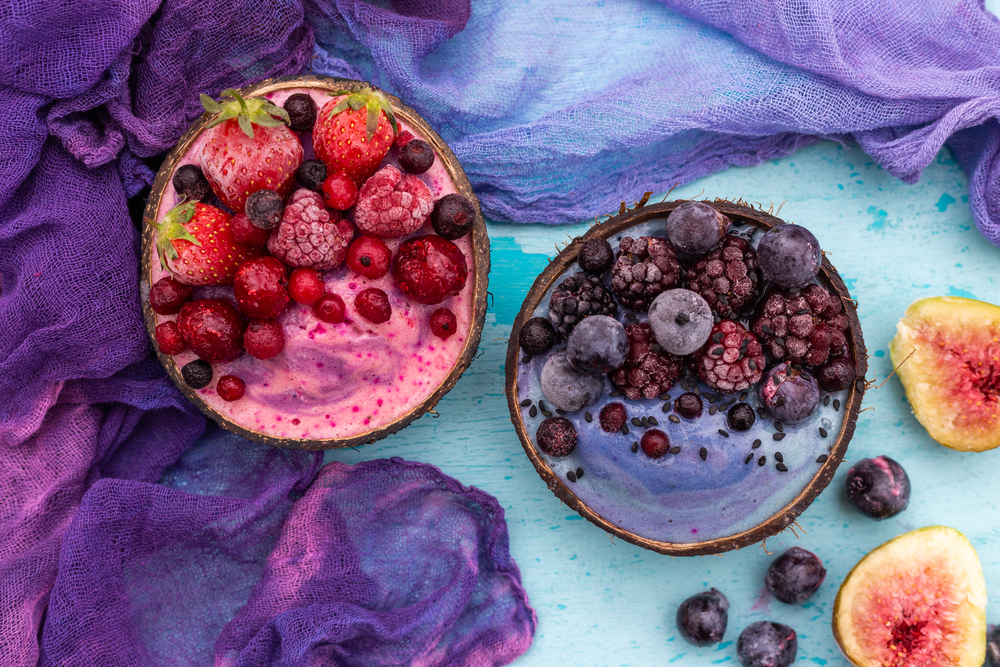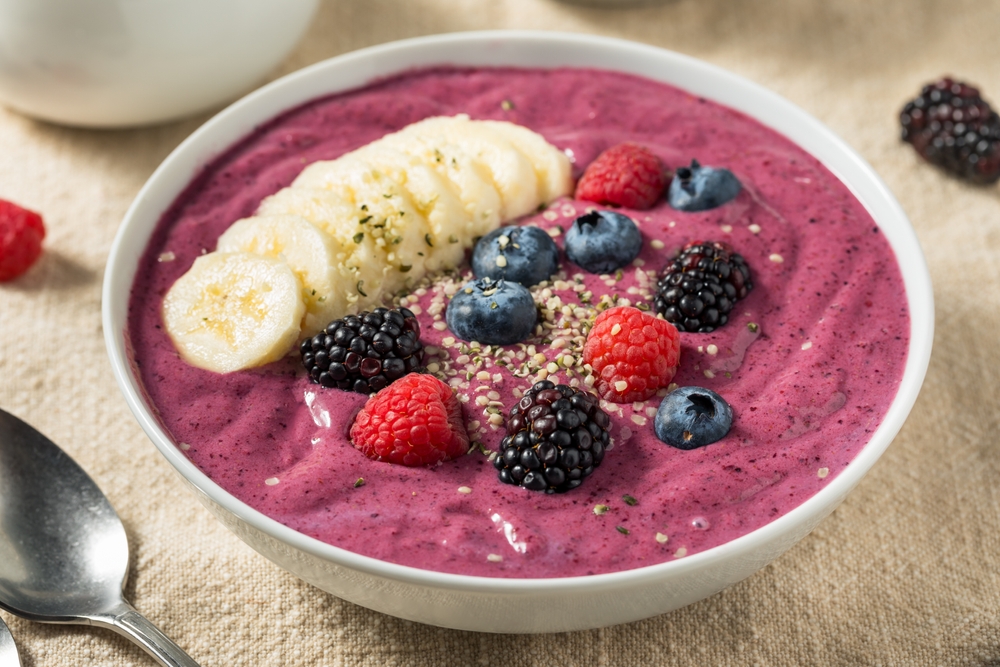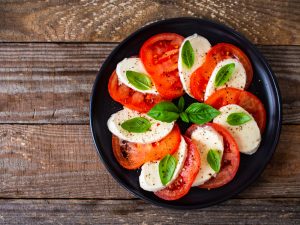Smoothie bowls have become the Instagram darling of healthy eating, but their weight loss benefits aren't guaranteed.
The answer depends entirely on how you build them—properly balanced bowls with controlled portions can support weight loss, while sugar-heavy versions with excessive toppings can sabotage your goals.
Keep reading to discover the exact formula for creating weight loss-friendly smoothie bowls and avoid the common mistakes that turn these colorful creations into calorie bombs.
The Weight Loss Reality: Why Smoothie Bowls Get Mixed Reviews
The smoothie bowl debate isn't black and white—these colorful creations sit in a nutritional gray area that can swing dramatically based on your choices.
Why Smoothie Bowls Can Actually Support Weight Loss
Smoothie bowls offer several advantages over traditional breakfast options when you construct them thoughtfully. Unlike smoothies that you drink quickly, bowls force you to eat more slowly with a spoon, which gives your brain time to register fullness signals. This simple change in eating behavior can prevent overconsumption.
The fiber content sets smoothie bowls apart from juicing, where valuable fiber gets stripped away during processing. When you blend whole fruits and vegetables, you retain all that fiber, which acts like a natural appetite suppressant. Fiber can't be digested by your body, so it stays in your stomach longer, creating that satisfying full feeling that lasts well into your morning.
Protein becomes your secret weapon for weight loss when added to smoothie bowls. High-protein content slows down how quickly your body absorbs food, which means sugar enters your bloodstream at a steadier pace rather than creating dramatic spikes. This stabilized blood sugar helps prevent the energy crashes that often lead to mid-morning snack attacks.
Healthy fats work alongside protein to extend satiety even further. When you add sources like nuts, seeds, or avocado, these fats slow sugar absorption and keep you feeling satisfied longer. The combination of fiber, protein, and healthy fats creates a trifecta that can effectively stave off hunger and cravings later in the day.
The Dark Side: When Smoothie Bowls Become Weight Loss Saboteurs
The same ingredients that make smoothie bowls potentially beneficial can quickly transform them into calorie bombs without proper planning.
Many people fall into the “health halo” trap, assuming that because smoothie bowls contain fruits and vegetables, they can add unlimited quantities without consequences.
Portion control becomes the make-or-break factor for weight loss success.
What starts as a reasonable breakfast can easily escalate into a meal containing more calories than a fast-food burger when you pile on multiple fruits, generous amounts of granola, nuts, seeds, coconut flakes, and other toppings.
The visual appeal of smoothie bowls often encourages people to keep adding colorful ingredients until the bowl becomes a Instagram-worthy masterpiece—and a caloric disaster.
The preparation method determines whether your smoothie bowl supports or sabotages your weight loss goals.
Homemade versions give you complete control over every ingredient, allowing you to balance macronutrients and monitor portions carefully.
You can choose unsweetened plant milks, limit fruit portions, and measure out appropriate amounts of healthy fats.
Commercial smoothie bowls present a different challenge entirely.
Many stores and smoothie shops serve portions that are significantly larger than what you'd make at home, often containing 600 calories or more in a single serving.
These commercial versions frequently include sweetened bases, syrups, and generous toppings that can push sugar content to levels comparable to dessert.
Understanding this nutritional divide helps explain why some people successfully lose weight incorporating smoothie bowls into their routine, while others find their weight loss efforts stalling.
The difference lies in recognizing that smoothie bowls aren't automatically healthy—they're a vehicle that can carry either nutritious, weight-loss-supporting ingredients or calorie-dense, sugar-heavy components that work against your goals.
The Science Behind Smoothie Bowl Satiety and Weight Control
Understanding how your body processes smoothie bowl ingredients reveals why some combinations keep you satisfied for hours while others leave you hungry within an hour.
How Fiber Creates Long-Lasting Fullness
Fiber operates as your body's natural appetite control system through a fascinating biological process.
When you consume fiber-rich smoothie bowls, this indigestible carbohydrate travels through your digestive system without breaking down.
Instead of being absorbed like other nutrients, fiber remains intact and takes up physical space in your stomach, creating mechanical fullness that your brain interprets as satisfaction.
This process extends far beyond simple stomach filling. Fiber also slows down gastric emptying, which means food stays in your stomach longer before moving to your small intestine.
This extended stomach residence time maintains that full feeling for several hours rather than the quick satisfaction you might get from refined foods.
Research shows that people who consume higher fiber meals report feeling satisfied for 3-4 hours longer than those eating low-fiber alternatives.
Soluble fiber, found in fruits like apples and berries commonly used in smoothie bowls, forms a gel-like substance when mixed with liquid.
This gel creates an even more pronounced satiety effect while also helping to slow the absorption of sugars from other ingredients in your bowl.
The result is steadier energy levels without the dramatic blood sugar fluctuations that trigger hunger pangs.
Protein's Role in Blood Sugar Management and Appetite Control
Protein transforms your smoothie bowl from a quick snack into a sustained energy source through several complex mechanisms.
When protein enters your digestive system, it triggers the release of hormones like GLP-1 and PYY, which directly signal your brain to reduce appetite and increase feelings of fullness.
These hormonal responses can last for several hours after eating.
The thermic effect of protein also works in your favor for weight control.
Your body burns approximately 20-30% of protein calories just to digest and process them, compared to only 5-10% for carbohydrates and 0-3% for fats.
This means a 30-gram protein smoothie bowl effectively burns 24-36 calories simply through digestion, creating a small but meaningful boost to your daily calorie burn.
High-protein content fundamentally changes how your body handles the sugars from fruits in your smoothie bowl.
Protein slows gastric emptying and delays carbohydrate absorption, which prevents rapid spikes in blood glucose.
Instead of experiencing a quick sugar rush followed by a crash, you get gradual, sustained energy release that keeps hunger at bay.
The Fat Factor: Why Healthy Fats Enhance Weight Loss
Healthy fats serve as powerful satiety enhancers through multiple pathways that support weight control.
When you include sources like nuts, seeds, or avocado in your smoothie bowl, these fats stimulate the release of cholecystokinin (CCK), a hormone that promotes feelings of fullness and satisfaction.
CCK also slows stomach emptying, extending the time you feel satisfied after eating.
Fats also play a crucial role in moderating blood sugar responses to the carbohydrates in your smoothie bowl.
The presence of fat slows carbohydrate absorption, creating a more gradual rise in blood glucose rather than sharp spikes.
This steadier blood sugar response prevents the insulin surges that can promote fat storage and trigger rebound hunger.
The satisfaction factor of fats extends beyond pure physiology into sensory satisfaction.
Fats enhance flavor perception and create a creamy, rich mouthfeel that registers as more satisfying to your brain.
This sensory satisfaction can prevent the psychological urge to keep eating that often occurs with low-fat meals that taste bland or unsatisfying.
Blood Sugar Responses: The Blending Effect
The impact of blending on blood glucose presents some surprising findings that challenge common assumptions about whole versus processed foods.
Research reveals that the effect varies significantly depending on the specific fruit and its cellular structure.
Fruits like mangoes show virtually identical blood glucose responses whether consumed whole or blended, suggesting that their natural sugar content and fiber ratio remain functionally similar regardless of processing method.
However, other fruits demonstrate different patterns when blended.
Some berries and stone fruits actually produce smaller blood sugar spikes when blended compared to eating them whole.
This counterintuitive finding occurs because blending can break down certain cellular structures that might otherwise slow sugar absorption, but it can also create better mixing with fiber and other components that moderate glucose release.
The key factor isn't whether fruits are blended, but rather what else you combine with them.
When fruits are blended alone with liquid, they can cause rapid blood sugar increases.
But when combined with protein, healthy fats, and additional fiber sources like leafy greens, the overall glycemic impact becomes much more moderate and weight-loss-friendly.
Macronutrient Balance: The Synergy Effect
The most powerful aspect of smoothie bowl science lies in how different macronutrients work together to create sustained satiety.
When you combine protein, healthy fats, and fiber-rich carbohydrates in appropriate ratios, you create a synergistic effect that's more powerful than any single macronutrient alone.
This macronutrient balance triggers multiple satiety pathways simultaneously.
Protein activates hormonal appetite suppression, fiber creates physical fullness and slows digestion, and fats enhance both hormonal responses and sensory satisfaction.
The result is a meal that satisfies hunger through multiple mechanisms, making it much easier to avoid snacking and overeating later in the day.
The timing of these satiety signals also works in your favor for weight control.
While simple carbohydrates might provide quick satisfaction that fades within an hour, the balanced macronutrient profile of a well-constructed smoothie bowl provides satisfaction that builds over the first 30 minutes after eating and then maintains for 3-4 hours.
This sustained satisfaction aligns perfectly with typical meal spacing for weight loss success.
Major Calorie Traps That Sabotage Weight Loss Goals
Even seemingly innocent smoothie bowl ingredients can quickly spiral into caloric disasters that derail your weight loss efforts before you finish breakfast.
The Hidden Calories in “Basic” Smoothie Bowls
What appears to be a simple, healthy breakfast can pack a surprising caloric punch that rivals many restaurant meals.
A standard smoothie bowl containing one medium banana, one cup of strawberries, one cup of blueberries, 1.7 ounces of oats, and 200ml of 2-percent milk delivers approximately 460 calories along with 1.4 ounces of sugar.
To put this in perspective, you're consuming nearly a quarter of your daily calories if you're following a 2000-calorie diet, and that's before adding any toppings.
The sugar content alone should raise red flags for weight loss goals. At 1.4 ounces, you're getting about 39 grams of sugar, which approaches the American Heart Association's recommended daily limit of 36 grams for men and exceeds the 25-gram recommendation for women.
This sugar load comes primarily from natural fruit sources, but your body processes it similarly to added sugars when consumed in large quantities without adequate protein and fat to slow absorption.
The calorie density becomes even more problematic when you consider the volume.
These 460 calories fit into a relatively small bowl that you might finish in 10-15 minutes, providing less satiety per calorie than many whole food alternatives.
Compare this to 460 calories worth of eggs, vegetables, and whole grain toast, which would likely keep you satisfied much longer while providing more varied nutrients.
The Topping Trap: How Small Additions Create Big Problems
Toppings transform smoothie bowls from reasonable breakfasts into caloric catastrophes faster than most people realize.
Popular additions like granola, nuts, seeds, coconut flakes, nut butters, and additional fruits can easily double or triple your calorie intake.
A seemingly modest sprinkling of granola adds 120-150 calories, while two tablespoons of almond butter contributes another 190 calories.
The visual nature of smoothie bowls encourages generous topping portions.
When you're arranging colorful ingredients for maximum Instagram appeal, it's easy to lose track of quantities.
What looks like a “small handful” of granola might actually be a quarter-cup serving, and those “few” sliced almonds can quickly become an ounce or more.
These visual estimation errors consistently lead people to underestimate their calorie intake by 200-400 calories per bowl.
Dried fruits present particularly sneaky calorie traps.
A small handful of dried mango or banana chips can add 150-200 calories while providing concentrated sugar without the fiber and water content that would normally help with satiety.
Unlike fresh fruits, dried versions offer little volume relative to their calorie content, making it easy to consume multiple servings without feeling physically full.
The combination effect multiplies these problems exponentially.
When you add granola, nuts, seeds, coconut flakes, and dried fruit to the same bowl, you can easily reach 800-900 total calories.
At this point, your “healthy” breakfast contains more calories than many people should consume in their largest meal of the day.
Commercial Smoothie Bowl Disasters
Store-bought and restaurant smoothie bowls present even greater challenges for weight-conscious consumers.
Commercial establishments often serve portions that are 50-100% larger than what you'd typically make at home, with some bowls containing 600-800 calories before toppings.
These oversized portions reflect business incentives to provide perceived value, but they completely ignore appropriate serving sizes for weight management.
The base ingredients in commercial smoothie bowls frequently include hidden calorie bombs.
Many shops use fruit juices, sweetened yogurts, or flavored protein powders that significantly increase sugar and calorie content compared to whole fruits and plain proteins.
Some acai bowl bases contain added sugars, fruit purees, or even ice cream to enhance flavor and texture, turning what should be a nutritious meal into a dessert disguised as health food.
Acai bowls specifically present unique challenges due to their popularity and marketing as superfoods.
While acai itself offers antioxidants, commercial acai bowls often contain massive portions of the fruit puree combined with guarana syrup, fruit juices, and generous toppings.
A typical store-bought acai bowl can easily contain 75 grams of sugar and 600-700 calories, with some extreme examples reaching over 1000 calories when loaded with nuts, granola, and multiple fruit toppings.
The lack of nutritional transparency in many commercial establishments makes it nearly impossible to make informed choices.
Unlike packaged foods with detailed labels, smoothie shops rarely provide comprehensive nutritional information, leaving customers to guess at calorie and sugar content.
This information gap often leads to dramatically underestimating the impact of these meals on weight loss goals.
The Sweetened Ingredient Multiplication Effect
Adding sweetened ingredients to smoothie bowls creates a multiplicative effect that can transform moderate sugar content into excessive levels that sabotage weight loss.
Sweetened yogurts, flavored plant milks, protein powders with added sugars, and honey or maple syrup toppings each contribute additional sugar that compounds the natural fruit sugars already present.
The problem intensifies because many people don't realize how much sugar they're adding through seemingly healthy choices.
Vanilla almond milk contains 7-16 grams of added sugar per cup depending on the brand, while flavored Greek yogurt can add another 15-20 grams.
When combined with multiple fruits and sweet toppings, the total sugar content can easily exceed 60-80 grams, which is more than double the recommended daily intake.
These sweetened additions also tend to increase cravings for more sweet foods throughout the day.
High sugar intake, even from “natural” sources, can trigger hormonal responses that promote continued sugar cravings and make it much harder to stick to appropriate portions at subsequent meals.
This creates a cycle where your morning smoothie bowl sets you up for poor food choices and overeating later in the day.
Multiple Fruit Servings: The Portion Distortion Problem
One of the most common mistakes in smoothie bowl preparation is treating fruits as unlimited ingredients simply because they're natural and healthy.
However, multiple fruit servings can quickly accumulate substantial calories and sugar even without any processed additions.
Two bananas, a cup of mango, and a cup of berries might seem reasonable in a large smoothie bowl, but this combination alone provides approximately 350 calories and 65 grams of sugar.
The concentration effect of smoothie bowls allows you to consume far more fruit than you would typically eat in whole form.
You might never sit down and eat two whole bananas, a mango, and a cup of berries in one sitting, but these same fruits blended into a smoothie bowl disappear quickly without triggering the same satiety signals as eating them separately.
Fruit portion distortion becomes especially problematic with calorie-dense options like bananas, mangoes, grapes, and pineapple.
A single large banana contains about 120 calories, while a cup of mango chunks adds another 100 calories.
When you use these as base ingredients and then add berries, you can easily reach 300-400 calories from fruit alone before considering any other components of your bowl.
The sugar content from multiple fruit servings also creates blood glucose spikes that can promote fat storage and trigger rebound hunger.
Even though fruit sugars come packaged with fiber and nutrients, consuming large quantities at once can overwhelm your body's ability to process them gradually, leading to similar metabolic responses as consuming candy or other high-sugar foods.
Building the Perfect Weight Loss Smoothie Bowl Formula

Creating a smoothie bowl that actually supports weight loss requires precise planning and specific ratios that work with your body's natural satiety mechanisms rather than against them.
Mastering Portion Control for Sustainable Results
The foundation of any weight loss-friendly smoothie bowl starts with understanding appropriate portion sizes.
Your ideal smoothie bowl should measure between 8-12 ounces total volume, which provides enough substance to feel satisfying without overwhelming your calorie budget.
This portion size aligns with standard meal replacement guidelines while leaving room for other meals and snacks throughout your day.
Measuring your smoothie bowl volume helps prevent the gradual portion creep that sabotages many weight loss efforts.
You can use a measuring cup to check your bowl size initially, but after a few weeks, you'll develop an intuitive sense of appropriate portions.
Most standard cereal bowls hold about 12-16 ounces when full, so your smoothie bowl should fill roughly three-quarters of a typical bowl.
The thickness of your smoothie bowl also impacts satiety and eating pace.
Aim for a consistency thick enough to eat with a spoon rather than drink through a straw.
This thicker texture forces slower consumption, giving your brain time to register fullness signals before you finish eating.
You can achieve this consistency by using less liquid and more frozen ingredients, or by adding fiber-rich components like chia seeds that absorb liquid and create bulk.
Strategic Protein Targeting for Maximum Satiety
Protein requirements for your smoothie bowl depend on whether you're using it as a meal replacement or a snack.
For meal replacement purposes, target 20-30 grams of protein to ensure adequate satiety and muscle protein synthesis.
This amount provides enough amino acids to maintain muscle mass during weight loss while triggering the hormonal responses that suppress appetite for several hours.
When using smoothie bowls as snacks between meals, reduce protein to around 10 grams to avoid excessive calories while still gaining appetite control benefits.
This lower protein amount works well for mid-morning or afternoon snacks that bridge longer gaps between main meals without disrupting your overall calorie balance.
The source of your protein significantly impacts both nutrition and taste.
Greek yogurt provides approximately 15-20 grams of protein per 6-ounce serving while adding creamy texture and probiotics for digestive health.
Plant-based protein powders offer concentrated protein without added sugars, with most quality options providing 20-25 grams per scoop.
Combining sources, such as using half a scoop of protein powder with some Greek yogurt, can help you hit protein targets while improving flavor and texture variety.
Calorie Management Without Sacrifice
Your target calorie range for meal replacement smoothie bowls should fall between 350-400 calories, providing enough energy and nutrients to sustain you for 3-4 hours without excess that could impede weight loss.
This calorie range allows for balanced macronutrients while fitting appropriately into most weight loss eating plans.
Breaking down these calories strategically maximizes satiety and nutritional value.
Allocate approximately 100-120 calories to protein sources, 150-200 calories to carbohydrates from fruits and vegetables, and 100-150 calories to healthy fats.
This distribution ensures you're getting adequate amounts of each macronutrient for optimal appetite control and sustained energy.
Tracking calories initially helps establish portion awareness, but you shouldn't need to count indefinitely.
After preparing smoothie bowls with measured ingredients for 2-3 weeks, you'll develop an intuitive understanding of appropriate portions for each component.
Focus on learning the calorie content of your most frequently used ingredients so you can make quick mental calculations without obsessive measuring.
Sugar Guidelines That Support Fat Loss
Managing sugar intake requires understanding both added and natural sugars in your smoothie bowl ingredients.
Your total daily sugar consumption should stay under 12 teaspoons (about 48 grams), with your smoothie bowl contributing no more than 20-25 grams to leave room for other foods throughout the day.
Natural fruit sugars count toward this total, so you need to balance fruit portions carefully.
One medium banana contains about 14 grams of sugar, while a cup of mixed berries adds another 10-12 grams.
These amounts can quickly approach your smoothie bowl sugar limit, making it crucial to choose lower-sugar fruits and control portions precisely.
Reading labels becomes essential when selecting yogurts, plant milks, and protein powders.
Plain Greek yogurt contains only natural milk sugars, while flavored varieties can add 15-20 grams of additional sugar.
Unsweetened plant milks typically contain 0-1 grams of sugar, compared to 7-16 grams in sweetened versions.
These seemingly small differences compound quickly when combined with fruit sugars.
Foundation Ingredients for Weight Loss Success
Building your smoothie bowl on the right base ingredients sets you up for success by providing maximum nutrition with controlled calories and sugar.
Leafy greens like spinach and kale should form the vegetable foundation of your bowl, contributing fiber, vitamins, and minerals with minimal calories or sugar impact.
Start with one cup of fresh greens or half a cup of frozen greens per bowl.
Low-glycemic berries offer the best fruit choices for weight loss smoothie bowls.
Strawberries, blueberries, raspberries, and blackberries provide antioxidants and fiber while maintaining relatively low sugar content compared to tropical fruits.
Limit total berry portions to 3/4 cup fresh or 1/2 cup frozen to control sugar and calories while still getting satisfying fruit flavor.
Greek yogurt serves as an ideal protein-rich base that adds creaminess without excess sugar.
Choose plain, unsweetened varieties and use 1/3 to 1/2 cup per bowl depending on your protein needs.
If you prefer plant-based options, select unsweetened protein powders with minimal ingredients and no added sugars or artificial sweeteners that might trigger cravings.
Healthy Fat Portions That Enhance Without Overwhelming
Healthy fats play a crucial role in smoothie bowl satiety, but portions must be carefully controlled due to their calorie density.
Limit total added fats to 1-2 tablespoons per bowl, which provides approximately 100-200 calories from fat sources.
This amount supplies enough fat for satiety and nutrient absorption without pushing your bowl into excessive calorie territory.
Nuts and seeds offer different nutritional profiles that can enhance your smoothie bowl's health benefits.
Almonds provide vitamin E and magnesium, while chia seeds contribute omega-3 fatty acids and additional fiber.
Walnuts offer brain-healthy omega-3s, and hemp seeds provide complete protein along with healthy fats.
Rotate between different options to maximize nutritional variety while maintaining portion control.
Preparation methods for nuts and seeds can impact both nutrition and satiety.
Raw nuts and seeds provide the most nutritional value, while lightly toasted versions offer enhanced flavor without added oils or salt.
Avoid pre-seasoned or sweetened varieties that add unnecessary sodium or sugar to your bowl.
You can enhance flavor naturally by adding a pinch of cinnamon or vanilla extract instead of relying on sweetened nut products.
The Perfect Formula Template:
- Base: 1 cup leafy greens + 1/3 cup plain Greek yogurt
- Fruit: 3/4 cup mixed berries (fresh or frozen)
- Protein boost: 1/2 scoop unsweetened protein powder (if needed to reach protein target)
- Healthy fats: 1 tablespoon mixed nuts/seeds
- Liquid: 2-4 tablespoons unsweetened plant milk (just enough to blend)
- Flavor enhancers: Cinnamon, vanilla extract, or fresh mint (calorie-free options)
This template provides approximately 320-380 calories, 25-30 grams protein, 18-22 grams sugar, and 12-15 grams fiber—hitting all the targets for effective weight loss support while maintaining satisfaction and nutritional balance.
Ingredients to Embrace vs. Ingredients to Avoid
Knowing which ingredients support your weight loss goals and which ones sabotage them can mean the difference between a satisfying, slimming breakfast and a calorie bomb that derails your progress.
Power Ingredients That Accelerate Weight Loss
Leafy greens represent the ultimate weight loss ingredients for smoothie bowls, providing massive nutritional value with virtually no caloric cost.
Spinach delivers iron, folate, and vitamin K while contributing only 7 calories per cup, making it possible to add substantial volume and nutrients without impacting your calorie budget.
The mild flavor disappears completely when blended with fruits, allowing you to pack in nutrition without compromising taste.
Kale takes nutritional density even further, providing vitamin C, calcium, and powerful antioxidants in just 33 calories per cup.
While kale has a stronger flavor than spinach, it pairs beautifully with berries and adds a vibrant green color that makes your smoothie bowl visually appealing. Both greens also contribute fiber that enhances satiety while supporting digestive health.
Berries stand out as the ideal fruit choice for weight loss smoothie bowls due to their exceptional fiber-to-sugar ratio.
Strawberries contain only 11 grams of sugar per cup while providing 3 grams of fiber and powerful antioxidants.
Blueberries offer similar benefits with 15 grams of sugar and 4 grams of fiber per cup.
Raspberries and blackberries provide even more fiber with less sugar, making them excellent choices for blood sugar control.
Greek yogurt transforms your smoothie bowl into a protein powerhouse while adding creamy richness that enhances satisfaction.
Plain Greek yogurt provides 15-20 grams of protein per serving with only 6-8 grams of natural milk sugars.
The probiotics in Greek yogurt also support digestive health and may contribute to weight management through improved gut bacteria balance.
Plant-based protein powders offer concentrated protein without the natural sugars found in dairy products.
Quality options provide 20-25 grams of protein per scoop with minimal calories from other sources.
Choose unflavored or naturally flavored varieties without added sugars, artificial sweeteners, or unnecessary fillers that might trigger cravings or digestive issues.
Ingredients to Limit for Consistent Progress
Multiple fruit servings create the most common pitfall in smoothie bowl preparation, even when using healthy fruits.
While one serving of fruit provides valuable nutrients and natural sweetness, two or three servings can push sugar content to levels that impair weight loss progress.
Limit total fruit to one serving per bowl, choosing lower-sugar options like berries over high-sugar tropical fruits.
Sweetened yogurts present a deceptive challenge because they appear healthy while containing significant added sugars.
Vanilla or fruit-flavored yogurts can contain 15-25 grams of added sugar per serving, effectively doubling the sugar content of your smoothie bowl compared to plain alternatives.
Even “lightly sweetened” varieties typically contain more sugar than you should consume in your entire smoothie bowl.
Milk alternatives with added sugars accumulate calories and sugar quickly, especially when you need several ounces to achieve proper blending consistency.
Sweetened almond milk contains 7-16 grams of sugar per cup, while sweetened coconut milk can contain even more.
These sugars add up rapidly when combined with fruit sugars, potentially pushing your bowl well beyond healthy sugar limits.
Ingredients to Avoid Completely
Granola represents one of the worst possible smoothie bowl toppings for weight loss, despite its healthy reputation.
Most commercial granolas contain 400-500 calories per cup, with significant amounts of added sugars and oils.
Even a modest quarter-cup serving adds 100-125 calories along with 8-12 grams of sugar, transforming your healthy breakfast into a calorie-dense meal without providing proportional satiety benefits.
Dried fruits concentrate natural sugars while removing the water content that normally helps with satiety.
A small handful of dried mango or banana chips can contain 150-200 calories and 30-40 grams of sugar, equivalent to eating 3-4 whole fruits without the fiber and volume that would normally signal fullness.
The concentrated sweetness of dried fruits also tends to trigger cravings for more sweet foods throughout the day.
Fruit juices as base liquids eliminate fiber while concentrating sugars, creating rapid blood sugar spikes that promote fat storage.
Orange juice contains 21 grams of sugar per cup with minimal fiber, while apple juice provides 24 grams of sugar.
Using juice as your liquid base essentially adds a serving of liquid candy to your smoothie bowl, undermining all the careful ingredient selection you've done with other components.
Smart Swaps That Maintain Flavor
Replacing sweetened ingredients with unsweetened alternatives maintains the flavors you enjoy while dramatically reducing sugar and calorie content.
Unsweetened almond milk, coconut milk, or cashew milk provide creamy texture with only 30-60 calories per cup and virtually no sugar.
These alternatives blend just as well as sweetened versions while allowing the natural fruit flavors to shine through.
Choosing whole fruits over juices or dried alternatives provides more volume, fiber, and satisfaction per calorie consumed.
Half a banana adds natural sweetness, potassium, and fiber for about 50 calories, while banana chips would provide similar calories in just a few small pieces.
Fresh berries offer antioxidants and fiber that dried versions lack, while frozen berries provide the same benefits with improved texture for blending.
Vegetables can replace some fruit content to add bulk and nutrients without excessive sugar.
Frozen cauliflower adds creaminess with only 25 calories per cup, while frozen zucchini contributes volume and mild flavor for even fewer calories.
These vegetable additions allow you to create larger, more satisfying bowls without compromising your weight loss goals.
The Balanced Approach Formula
Achieving consistent weight loss success requires following a structured approach that balances all macronutrients appropriately.
Your ideal smoothie bowl should contain one serving of protein (Greek yogurt or protein powder), one serving of fruit (preferably berries), 1-2 tablespoons of healthy fats (nuts or seeds), and 1-2 servings of vegetables (leafy greens or frozen vegetables).
This balanced approach ensures you're getting adequate protein for muscle maintenance and appetite control, enough carbohydrates for energy and satisfaction, sufficient healthy fats for satiety and nutrient absorption, and plenty of fiber for digestive health and blood sugar control.
The combination of these macronutrients creates synergistic effects that enhance weight loss while maintaining nutritional adequacy.
Timing your smoothie bowl consumption also impacts its effectiveness for weight loss.
Consuming your bowl as breakfast provides sustained energy for your most active part of the day, while the protein content helps maintain muscle mass during any caloric deficit.
The fiber and protein combination also helps stabilize blood sugar throughout the morning, preventing energy crashes that might trigger poor food choices later.
Quality Control Through Homemade Preparation
Preparing smoothie bowls at home gives you complete control over every ingredient, allowing you to maintain quality standards that support your weight loss goals.
Commercial smoothie bowls often contain hidden sugars, oversized portions, and low-quality ingredients that can sabotage your progress.
Home preparation ensures you know exactly what you're consuming while keeping costs significantly lower than purchasing pre-made options.
Batch preparation can streamline your morning routine while maintaining quality control.
Portion out greens, fruits, and protein sources into individual freezer bags on weekends, then simply blend with liquid each morning.
This approach saves time while ensuring consistent portions and preventing the temptation to add extra ingredients when you're rushed or hungry.
Investing in quality preparation tools enhances both convenience and results.
A high-powered blender creates smooth, creamy textures without requiring excess liquid, while accurate measuring tools help maintain appropriate portions.
Digital kitchen scales provide the most precise portion control, especially for calorie-dense ingredients like nuts, seeds, and protein powders where small measurement errors can significantly impact your daily calorie intake.
Smart Strategies for Long-Term Weight Loss Success
Sustainable weight loss with smoothie bowls requires strategic thinking beyond individual ingredients—you need systems and habits that support your goals over months and years, not just days.
The Home Preparation Advantage for Lasting Results
Taking control of your smoothie bowl preparation at home creates the foundation for consistent weight loss success.
When you prepare smoothie bowls in your own kitchen, you eliminate the guesswork and hidden ingredients that plague commercial options.
You can measure portions precisely, choose quality ingredients, and adjust recipes based on your specific weight loss progress and preferences.
Home preparation also allows you to develop crucial food awareness skills that extend beyond smoothie bowls.
As you measure ingredients and track results, you naturally develop better portion control instincts that benefit all your meals.
This hands-on experience with measuring, weighing, and combining ingredients builds the practical knowledge you need for long-term weight management success.
The cost savings from home preparation can be substantial, making it easier to invest in higher-quality ingredients that support your health goals.
Premium protein powders, organic produce, and specialty items like chia seeds or hemp hearts become more affordable when you're not paying restaurant markups.
These savings can be redirected toward other aspects of your weight loss journey, such as gym memberships or cooking equipment.
Meal prep strategies amplify the benefits of home preparation while reducing daily decision fatigue.
Spend 30 minutes on Sunday washing and portioning greens, freezing fruit portions, and organizing protein sources.
This preparation makes healthy choices automatic during busy weekday mornings when you might otherwise reach for less healthy convenience options.
Strategic Frequency Management
Using smoothie bowls as occasional meal replacements rather than daily staples prevents both nutritional monotony and potential nutrient gaps that could undermine your long-term health.
Aim for 3-4 smoothie bowl meals per week maximum, leaving room for varied whole food meals that provide different nutrients and eating experiences.
This moderate frequency approach prevents flavor fatigue and maintains the psychological satisfaction that comes from dietary variety.
When smoothie bowls become your daily breakfast routine, you miss opportunities to practice portion control with other foods and may develop overly rigid eating patterns that become difficult to maintain in social situations or while traveling.
Rotating smoothie bowls with other healthy breakfast options also helps you develop a broader repertoire of quick, nutritious meals.
Alternating between smoothie bowls, vegetable omelets, Greek yogurt parfaits, and overnight oats gives you multiple strategies for healthy eating rather than relying on a single approach that might become unsustainable.
Consider your weekly schedule when planning smoothie bowl frequency.
They work particularly well on busy mornings when you need portable nutrition, after morning workouts when you want easily digestible nutrients, or during weeks when fresh produce needs to be used before spoiling.
This strategic timing maximizes their benefits while preventing overreliance.
Calorie Tracking for Awareness and Accountability
Even healthy ingredients can sabotage weight loss when portions become excessive, making calorie awareness crucial for long-term success.
Track your smoothie bowl calories for at least two weeks to establish baseline awareness of how your typical ingredient combinations impact your daily calorie budget.
This tracking period helps identify any portion creep or ingredient additions that might be undermining your progress.
Use a food tracking app or simple notebook to record not just calories, but also hunger levels before and after eating, energy levels throughout the morning, and any cravings that arise later in the day.
This comprehensive tracking reveals patterns that help you optimize your smoothie bowl formula for maximum satisfaction and weight loss support.
Pay special attention to calorie-dense ingredients like nuts, seeds, nut butters, and protein powders where small measurement errors can create significant calorie differences.
A “heaping” tablespoon of almond butter instead of a level tablespoon adds an extra 50-70 calories that compounds over time.
Digital kitchen scales provide the most accurate measurements for these ingredients.
After establishing portion awareness through tracking, you can transition to intuitive eating while maintaining periodic check-ins.
Weigh yourself weekly and reassess your smoothie bowl portions if weight loss stalls or reverses.
This flexible approach prevents obsessive calorie counting while maintaining accountability for your results.
Critical Warning Signs to Monitor
Several red flags indicate your smoothie bowl strategy may be undermining your weight loss goals.
Bowls exceeding 500 calories venture into territory where they provide more energy than many people need for breakfast, potentially creating calorie surpluses that prevent weight loss.
If your typical bowl approaches or exceeds this threshold, reduce portions or swap higher-calorie ingredients for lower-calorie alternatives.
Added sugar content above 25 grams signals that your bowl has shifted from a balanced meal toward a dessert-like indulgence.
This sugar level can trigger blood sugar spikes and crashes that promote hunger and cravings throughout the day.
Natural fruit sugars count toward this total, so multiple fruit servings combined with sweetened yogurt or plant milks can quickly push you over healthy limits.
Lack of adequate protein represents another critical warning sign that undermines both satiety and muscle preservation during weight loss.
Smoothie bowls without sufficient protein leave you hungry within 1-2 hours and fail to provide the muscle-supporting amino acids needed during caloric deficits.
Aim for at least 15-20 grams of protein per bowl when using it as a meal replacement.
Monitor your hunger patterns after consuming smoothie bowls.
If you find yourself hungry again within two hours, your bowl likely lacks adequate protein, healthy fats, or fiber to provide lasting satiety.
Similarly, if you experience energy crashes or sugar cravings mid-morning, your bowl may contain too much sugar relative to protein and fat.
Avoiding Commercial Preparation Pitfalls
Commercial smoothie bowls present numerous challenges for weight loss success due to unknown ingredient profiles, oversized portions, and profit-driven formulations that prioritize taste over nutrition.
Even establishments that market themselves as health-focused often use ingredients and portions that exceed reasonable limits for weight management.
The lack of nutritional transparency in most smoothie shops makes informed choices nearly impossible.
Without detailed ingredient lists and accurate nutritional information, you can't assess whether a commercial bowl fits your weight loss goals.
Many shops also use pre-made bases, syrups, and toppings that contain hidden sugars and preservatives not found in homemade versions.
Portion sizes at commercial establishments typically exceed home portions by 50-100%, reflecting business incentives to provide perceived value rather than appropriate nutrition.
What appears to be a single serving might actually contain 2-3 appropriate portions, creating calorie intakes that can derail several days of careful eating.
When commercial options become necessary due to travel or convenience needs, research establishments beforehand and ask detailed questions about ingredients and preparation methods.
Look for places that allow customization, choose smaller sizes when available, and consider eating only half the portion while saving the rest for later.
Treating Smoothie Bowls as Complete Meals
Successful weight loss requires viewing smoothie bowls as complete, balanced meals rather than healthy desserts or snacks that can be consumed without consideration for overall daily nutrition.
This mindset shift prevents the tendency to add unlimited toppings or consume additional foods shortly after finishing your bowl.
Complete meal thinking involves ensuring your smoothie bowl provides adequate protein, healthy fats, fiber, and micronutrients to sustain you for 3-4 hours until your next planned meal.
This approach prevents the snacking and grazing that often occurs when meals don't provide complete nutrition and lasting satiety.
Plan your remaining daily meals around your smoothie bowl to ensure balanced overall nutrition.
If your bowl provides primarily carbohydrates and protein, focus on including more healthy fats and vegetables in subsequent meals.
This whole-day nutrition planning prevents both nutrient gaps and excessive calorie intake from trying to compensate for incomplete meals.
Understanding Short-Term vs. Long-Term Considerations
Smoothie bowls can provide effective short-term weight loss support through their controlled calorie content and high fiber satiety effects.
The combination of protein, fiber, and healthy fats helps many people reduce overall daily calorie intake while maintaining satisfaction and energy levels during the initial weeks or months of a weight loss program.
However, long-term reliance on smoothie bowls as primary meal replacements carries risks of nutrient deficiencies and eating pattern rigidity that can undermine sustainable weight management.
No single food or meal type provides all the nutrients your body needs, and excessive dependence on any one approach can lead to both nutritional and psychological problems.
The key to long-term success lies in using smoothie bowls as one tool in a diverse arsenal of healthy eating strategies.
They work well for busy mornings, post-workout nutrition, or periods when you need structured meal options, but they shouldn't replace your ability to prepare and enjoy a variety of whole food meals.
Gradually expand your healthy eating repertoire as you progress in your weight loss journey.
Use the portion control and ingredient awareness skills developed through smoothie bowl preparation to improve other meals and snacks.
This evolution from structured meal replacements to broader healthy eating skills creates the foundation for lifelong weight management success.
Consider smoothie bowls as training wheels that help you develop better eating habits rather than a permanent solution.
As you become more comfortable with portion control, macronutrient balance, and meal planning, you can reduce reliance on structured approaches like smoothie bowls while maintaining the healthy habits they helped you develop.
Conclusion
Smoothie bowls can absolutely support weight loss when you build them with proper portions, balanced macronutrients, and controlled sugar content.
The difference between success and failure lies in treating them as complete, measured meals rather than unlimited healthy indulgences, while avoiding the calorie traps that transform nutritious breakfasts into diet disasters.
Master the formula of 8-12 ounces total volume with adequate protein, minimal added sugars, and strategic ingredient choices, and you'll have a powerful tool for sustainable weight management.







